Medical Problems
Playlist includes 8 training videos
Minor to life-threatening emergencies make up the possible scenarios a rescuer trained in first aid may have to deal with in responding to medical problems. Appropriate training is crucial.
Breathing Problems
Illnesses such as pneumonia and underlying lung diseases like asthma or emphysema can cause breathing problems. Anxiety, seizure, stroke, heart attack, and other problems with certain body systems may also cause breathing issues.
An inability to talk due to breathlessness, producing unusual sounds, noisy breathing, and fast or shallow breathing are all signs indicative of a breathing problem. A sort of musical note while breathing (which sounds similar to wheezing) is often made by people with asthma. Wheezing can also be caused by severe allergic reactions. A partial blockage of the upper airway may cause high-pitched sounds during inhalation.
People with chronic lung disease and asthma should be familiar with using breathing medications. Atrovent inhalers and albuterol are common medications. The effect of these medications can be improved by using a spacer, or a tube connected to the inhaler that keeps medication in place until the person breathes it in. However, there may be trouble using the inhaler if the person is in severe distress. If the person is in significant distress, call 911/EMS.
Technique for using an inhaler:
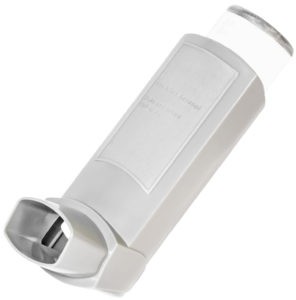
Figure 4
- Shake the inhaler canister.
- If available, place the opening of the inhaler into the spacer.
- Instruct the person to fully exhale.
- Place the spacer or inhaler in their mouth.
- Press down on the top of the inhaler canister while the person inhales slowly and deeply.
- If possible, tell the person to hold their breath for 10 seconds.
- If respiratory problems persist, repeat the process.
- Stay with the person until the emergency response arrives or until symptoms improve.
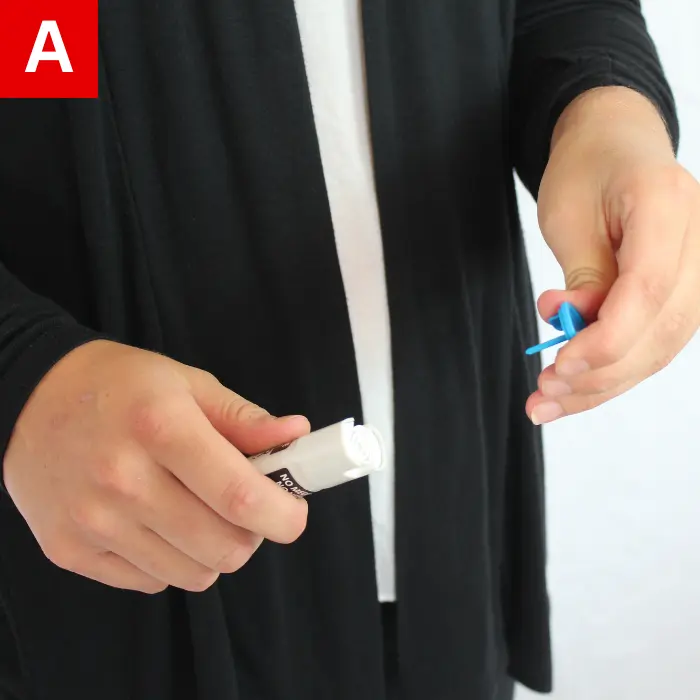
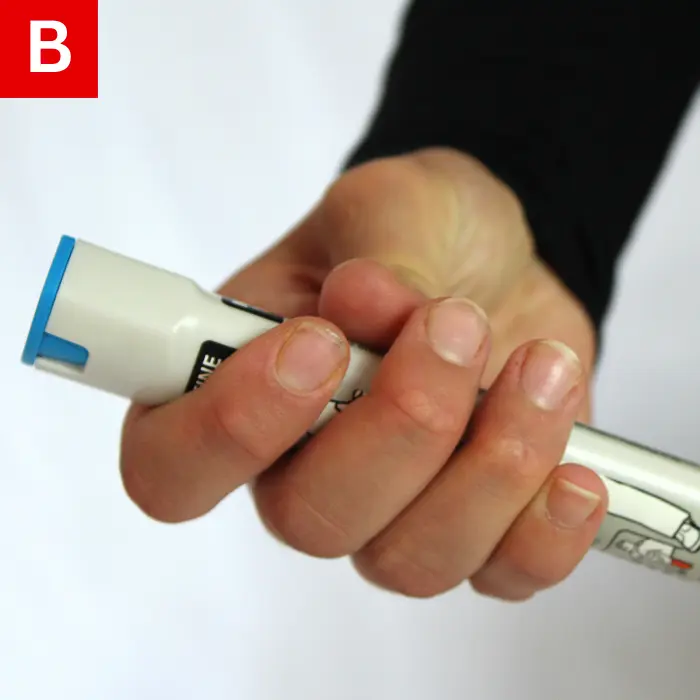
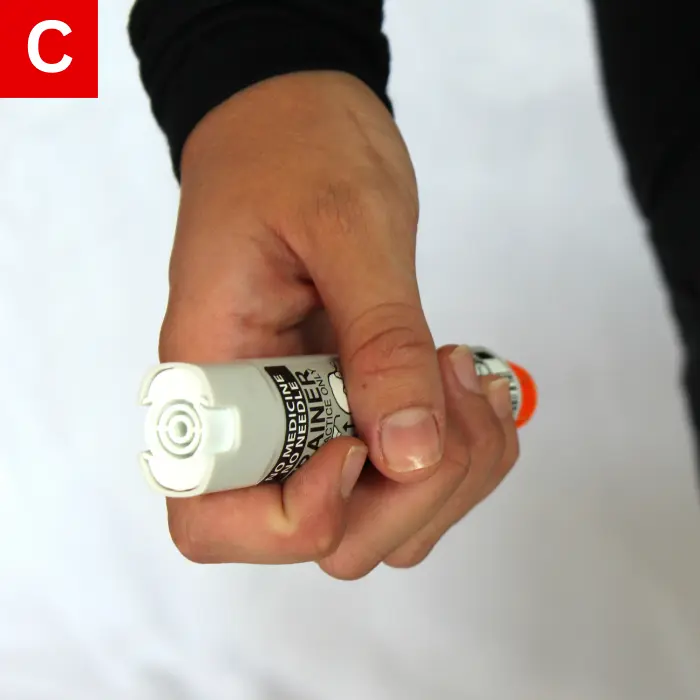
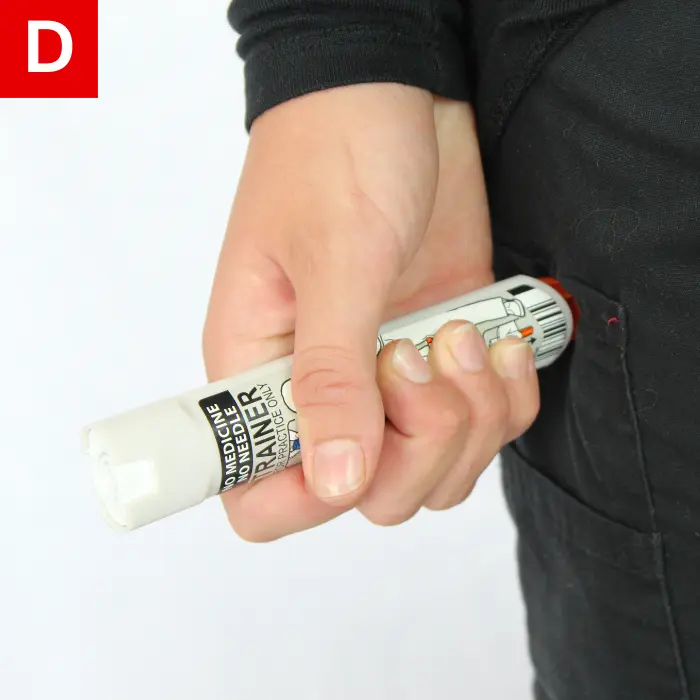
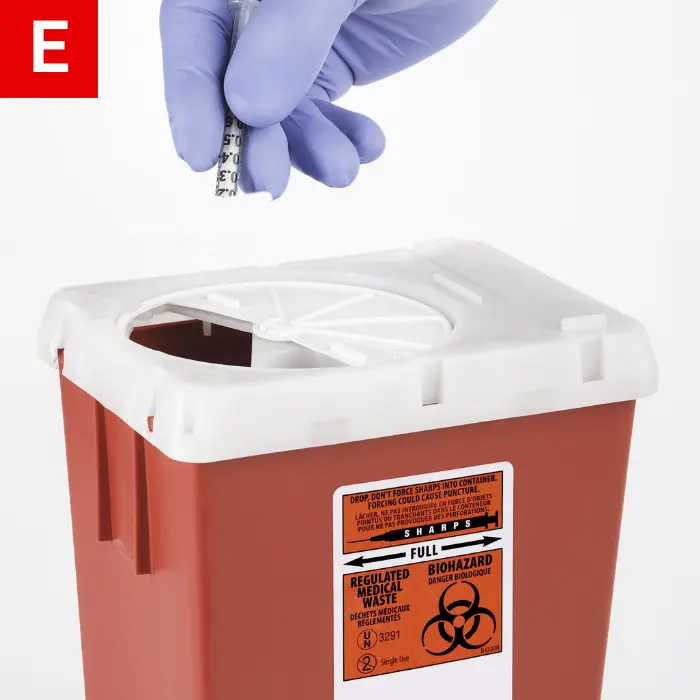
Figure 5
Allergic Reactions
Environmental triggers such as pollens, dust, or chemical fumes, as well as an adverse reaction to foods, medications, or insect stings, can all cause allergic reactions. Potentially fatal reactions may arise from hornet, wasp, or bee stings, while fruits, eggs, and nuts are common food triggers. Symptoms can vary from mild (itching and hives) to severe (life-threatening swelling of the airway, lips, and tongue).
At the first sign of a severe allergic reaction, epinephrine should be given, as it is a life-saving medication. It is simple to use EpiPen and other commercially available epinephrine pens.
The basic instructions for using epinephrine pens are as follows:
- Hold your fist around the pen, then remove the safety release cap (Figure 5a & 5b).
- Hold the orange side of the pen against your outer mid-thigh (clothed or unclothed) (Figure 5c).
- Swing and push the pen in place for 3 seconds after you have pushed down hard and heard or felt a click (Figure 5d).
- For 10 seconds, massage the injection site after removing the pen.
- Use a sharps container to properly dispose of the device (Figure 5e).
- Note the time of the injection.
- Seek medical care.
Heart Diseases
The leading cause of death in the United States is heart disease. During a heart attack, your prompt actions can spell the difference between life and death. Muscle death can be caused by blocked blood flow to the heart tissue in a person experiencing a heart attack. To limit damage to the heart muscle, it is critical to have a prompt response and proper medical attention.
Crushing, squeezing, pressure, and aching are just some ways chest discomfort may be described. Classic signs of a heart attack are less likely to appear in certain persons, like women and people with diabetes. For them, nausea or unexplained fatigue may be more subtle signs of a heart attack. For some individuals, the only sign of an impending heart attack may be shortness of breath.
A significant cause of delay in seeking care is denial. Most believe themselves to be too healthy or too young to experience a heart attack. However, a heart attack can occur even in those with only minimal risk factors.
The severity of a heart attack can be reduced with aspirin, which also keeps blood clots from growing larger. Give aspirin to the person if there are no signs that suggest a stroke, no serious bleeding, and no true allergy to aspirin.
Do the following when caring for a person who may be having a heart attack:
- Stay calm: both you and the person experiencing trouble should remain calm.
- Relax the person by having them sit or lie down.
- Call 911/EMS and activate the emergency medical system.
- Give 2 to 4 baby aspirins or half to a full adult aspirin tablet. The aspirin should not be enteric-coated.
- Heart attacks can quickly become life-threatening, so prepare to deliver CPR.
A heart attack is a medical emergency that can become life-threatening. Emergency medical services (EMS) must transport people with heart attack symptoms to the hospital immediately. Driving themselves to the hospital is not an option for people suspected of having a heart attack. If they refuse to wait for the EMS, someone should travel with them.
Fainting
A common reaction to a variety of conditions is fainting; another possible cause is periods of intense emotional stress. Abnormal or erratic heart rhythm and other serious conditions may also result in fainting. When standing up suddenly, severely dehydrated persons may also faint.
A person passes out due to the body’s reaction to decreased blood flow to the brain. Lying down can help the blood flow to the brain more freely.
Do the following when caring for a fainting person:
- Make sure the scene is safe.
- Help the person lie down.
- If possible, elevate their legs.
- Call 911/EMS if the person becomes unresponsive or if there is no rapid movement.
It is also possible to faint while a person is seated in a chair. In these situations, carefully assist the person to the floor. If the person has fallen, check for potential injuries. Call 911/EMS immediately if the person does not quickly regain consciousness. There is a wide range of problems that can cause fainting, some of which are life-threatening. Call 911/EMS if you are unsure about the cause.
Low Blood Sugar in Persons with Diabetes
A person’s ability to regulate blood sugar is affected by diabetes. Symptoms are produced by fluctuations in blood sugar in either direction (too much or too little). Illness, taking too much insulin, skipping meals, and stress are some common causes of low blood sugar in people with diabetes.
Altered states of consciousness like a loss of consciousness, confusion, and agitation are caused by low blood sugar. Seizure-like activity, weakness, and excessive tiredness can be results of very low blood sugar.
When dealing with a person suspected of having low blood sugar, do the following:
- Give them milk, fruit juice, or a non-diet soft drink, as these contain sugar.
- Encourage them to lie down or sit.
- Call 911/EMS.
- Encourage them to eat if their symptoms improve.
Good ways to quickly increase blood sugar include eating glucose gel or tablets. Packets of sugar, jelly from restaurants, and honey are good alternatives that are usually readily available. These should be included in the first aid kit.
Do not give any food or drink to a person with diabetes who is having trouble sitting up or swallowing safely, as this may result in aspiration or choking.
Stroke
Sometimes known as a brain attack, the medical emergency known as a stroke is a result of bleeding in the brain or a blocked blood vessel.
The following are symptoms a person experiencing a stroke may have:
- Severe headache
- Loss of consciousness
- Difficulty maintaining balance or walking
- Vision loss
- Numbness
- Weakness on one side of the body
- Unintelligible or slurred speech
- Facial droop
Time is critical, as stroke is a neurological emergency.
Do the following if a person is suspected of having a stroke:
- Call 911/EMS immediately.
- Help the person sit or lie down.
- Retrieve a first aid kit and AED.
- Take note of the time the neurologic symptoms were first observed and the last time the person was without symptoms.
- Prepare yourself to perform CPR.
Seizures
An irregular electrical discharge in the brain may cause a seizure, which results in abnormal body motion. One or both sides of the body can be affected by seizures. Some seizures cause a blank-stare type of behavior, whereas most seizures cause rhythmic jerking motions. Falling to the ground, biting the tongue, and loss of control of bowel and bladder are some things you have to look out for with a person having a seizure. A brief period of unresponsiveness often accompanies seizures.
Heart-related illness, ingestion of a toxin, heart disease, head injury or trauma, low blood sugar, and epilepsy are just some of the causes of seizures or seizure-like activity.
Do the following when caring for a person experiencing a seizure:
- If needed, help them to the ground.
- Prevent injury by clearing the area around them.
- Place a small towel or pillow under their head.
- Call 911/EMS.
Do the following after the seizure:
- Check the person’s pulse; remember that seizure-like activity is a result from heart problems.
- Someone may be vomiting during or after a seizure, so place the person on their side so they won’t choke.
- Wait until help arrives.
Restraining a person having a seizure is not recommended. Also, do not put anything between their teeth or open their mouth.
Though the person’s eyes may be open, a person experiencing a staring-type or absence seizure will not respond. These episodes are not associated with a loss of consciousness or with jerky body motion, and they are generally brief. A medical evaluation is warranted in this type of event, which should be treated as seriously as all other seizures.
Shock
Heart problems, severe dehydration, severe allergic reaction, blood loss, and overwhelming infection are just some of the many potential causes of shock. Shock occurs when blood flow is significantly reduced, typically because the body is not receiving enough oxygen. Losing consciousness and failing to respond are common symptoms of shock.
Signs and symptoms of shock include:
- Clammy skin
- Changes in behavior like unresponsiveness, confusion, or agitation
- Vomiting or nausea
- Lightheadedness and dizziness
- A sickly bluish, gray, or pale skin color
Do the following when confronted with a shock victim:
-
Call 911/EMS and activate the emergency response system.
-
Help the person lie down, then elevate their legs.
-
Keep the person warm with blankets.
-
Prepare yourself for the possibility of performing CPR.
-
Until help arrives, stay with the person.
